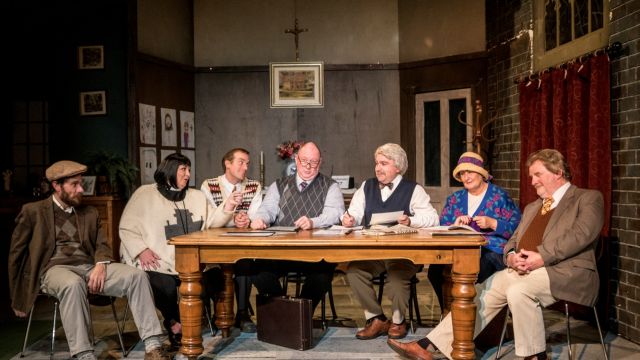Vicar of Dibley
When choosing The Vicar of Dibley for stage, directors are under pressure to recreate exactly the recognisable TV characters, stories and jokes. Hobart Director Ingrid Ganley, for John X and Graeme Paine, had a good cast who gave us what we expected to see from the oft-repeated TV program.
Di Richards, a well-known singer with enormous stage presence, filled the role of Geraldine admirably, although a little breathily. Despite his natural pleasantness, Paul Levett (David Horton) competently brought off the acerbic nastiness of the TV David.
Darren Sangwell (Hugo Horton) and Anna Kidd (Alice Tinker), well matched as the lovers, gave all we wanted as the gormless, goofy, drippy, much-loved characters. Kidd, a terrific young character actor with perfect timing and adaptability, suited Alice to a T(inker). Sangwell, known for his huge body of work as a director, producer, teacher, actor, singer and everything theatrical, had Hugo - a gift role for him to enjoy the centre of stage.
 Jeff Keogh (Owen Newitt) was a delight, and gave a good Owen recreation. David Gilkes (Frank Pickles) and Pip Tyrell (Letitia Cropley) were also true to our expectations of the TV cast. Graeme Paine (Jim Trott) had fun with his lines – essentially, “no,no, no - yes” - and appearing to fall asleep on stage. The priceless Cathy Spencer (lady at the wedding) was a lovely, albeit small addition, to the happy cast.
Jeff Keogh (Owen Newitt) was a delight, and gave a good Owen recreation. David Gilkes (Frank Pickles) and Pip Tyrell (Letitia Cropley) were also true to our expectations of the TV cast. Graeme Paine (Jim Trott) had fun with his lines – essentially, “no,no, no - yes” - and appearing to fall asleep on stage. The priceless Cathy Spencer (lady at the wedding) was a lovely, albeit small addition, to the happy cast.
The charming set, although static, was excellent, but a bit crowded, with both the Parish Hall and the Vicarage in full view, mostly using lighting to delineate the scene changes. Other scene changes created with the use of the Cantiamo Ladies Choir (The Vicar Choir), were, in effect, the theme music, and well done.
With a big cast of larger-than-life characters, there was not much room for movement, and to my mind, this affected the pace. The crowdedness was probably due to the recreation of our expectations of a TV set, and the translations of the television genre to the stage genre. The audience loved it - they got what they came to see, laughs galore. Pleasant theatre fun – a good time was had by all.
Merlene Abbott
Subscribe to our E-Newsletter, buy our latest print edition or find a Performing Arts book at Book Nook.

